Advertisement
Kugels to Couscous: Great Jewish-French Recipes
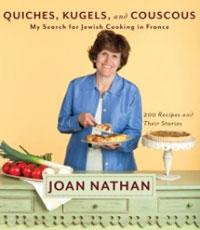 The first Jews came about two thousand years ago to France. There’s been a lot of eating and cooking since then.
The first Jews came about two thousand years ago to France. There’s been a lot of eating and cooking since then.There have been Kosher butchers serving whole French towns, and Yeshiva teachers moonlighting as truffle hunters.
Old Jewish traditions – Ashkenazi and Sephardic – have been woven into the fabric of French cuisine, and vice versa, says cookbook author Joan Nathan. Her new book is Quiches, Kugels, and Couscous: My Search for Jewish Cooking in France.
Nathan finds Jewish influences in eggplant caviars and the roots of ratatouille, in the foie gras trade, and leftover challah dough as a tarte base in Alsace. It’s also there for her in the origins of French chocolate, in North African tagines, in a mushroom croustada, and in foods for Hannukah.
And the influence remains strong to this day, Nathan tells On Point (listen to her interview here).
"In Paris alone, there are over 30 kosher supermarkets that have everything," she says, "They're small, and the meats are beautifully prepared. They're French."
Some recipes from Joan Nathan's Quiches, Kugels, and Couscous (courtesy of Knopf):
FRIDAY NIGHT ALGERIAN CHICKEN FRICASSEE
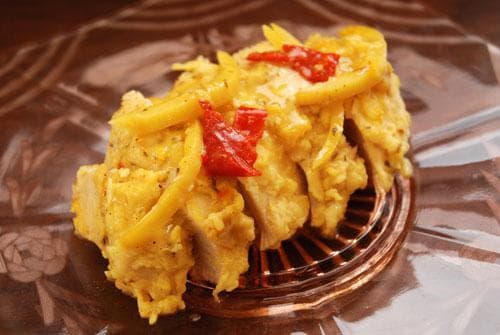
When I was in Bordeaux, I received a call from Yael Nahon, a young woman in public relations who loves to cook. We decided to meet at the Places des Quinquonsses, a beautiful square near the harbor with shimmering water where children play in the summer. In her spare time she is trying to recreate the dishes of her mother and grandmother who came from Oran, in Algeria. Like many other North Africans, she uses spigol (an Algerian spice combination of hot pepper, saffron, and cumin, now packaged in Marseille) to enhance the flavor of her chicken dishes. This is a dish Yael ate every Friday night of her childhood. It was always preceded by several salads and followed by cookies and fruit.
6 boneless, skinless chicken breasts
Salt and freshly ground pepper to taste
2 large eggs, beaten
1 cup all purpose flour
Vegetable oil for frying
2 cloves garlic, peeled and left whole
Pinch of saffron
Pinch of cumin
½ teaspoon of hot pepper or to taste
1 ½ teaspoons grated fresh ginger
¼ teaspoon nutmeg
A sprig of thyme
1 bay leaf
Juice and rind, chopped, of 1 lemonSeason the chicken breasts with salt and freshly ground pepper to taste. Put the flour in one bowl and the eggs in another, and season both with salt and freshly ground pepper. Heat about ½ inch of oil in a large frying pan. Roll the chicken first in the egg, then in the flour. Fry in the oil until golden on each side, just a minute or two. Drain the chicken on paper towels. Discard all but a thin film of the oil. Add the garlic and sauté briefly over medium heat. Return the chicken to the pan, and add about 1 cup of water, or enough almost to cover the chicken. Sprinkle on top a pinch of saffron, a pinch of cumin, the hot pepper, the bay leaf, the ginger, and the nutmeg, and toss in the thyme and bay leaf. Squeeze the lemon over all, then add the lemon rind to the liquid. Bring to a boil, cover, and simmer for about 20 minutes, or until the chicken is cooked through and tender. Serve with rice or boiled potatoes.
Yield: 4 to 6 servings (M)
ALSATIAN PEAR KUGEL WITH PRUNES
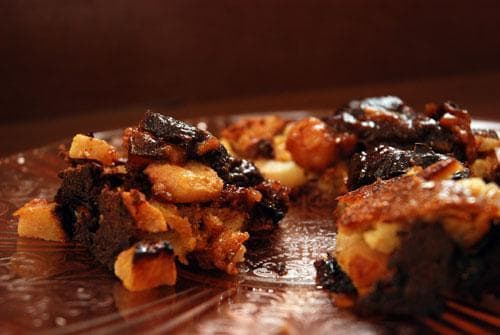
Bosc pears and Italian blue plums (dried for use in the winter) are fruits that were most often put into kugel. This very old Alsatian Sabbath kugel uses leftover bread which is soaked in water, squeezed to remove any excess moisture, and then mixed with the dried or fresh fruit and left to stew in the oven overnight. Some, like this version, include onions, which add a savory dimension to the sweetness of the fruit and the dough. I love this dish, which I serve in my home for Rosh Hashanah and the Sabbath as a side dish with brisket.
5 tablespoons vegetable oil
2 pounds ripe Bosc pears
2 small onions (about 1/2 pound), peeled and cut into 1-inch dice
Salt to taste
½ loaf thick white bread, about 7 ounces
3/4 cup sugar
8 tablespoons butter or pareve margarine, melted
2 large eggs
2 cups pitted prunes
1 teaspoon cinnamon
Juice of 1 lemon
Preheat the oven to 350 degrees and grease a 9-inch springform pan with 2 tablespoons of the oil.
Peel the pears and cut all but one of them into 1-inch cubes.
Heat the remaining 3 tablespoons of the oil over a medium-high heat in a skillet. Lightly sauté the onions until they are translucent. Remove from the heat, salt lightly, allowing them to cool slightly.
Soak the bread for a few seconds in lukewarm water and squeeze dry. Put in a large bowl and, using a wooden spoon or spatula, mix with ¼ cup of the sugar, and the butter or pareve margarine. Stir in the eggs, onions, and half of the diced pears, setting aside the remaining pears for the sauce.
Pour the batter into the spring form pan and bake for 2 hours.
While the kugel is cooking, make the sauce. In a heavy saucepan set over medium-high heat, put 1 cup of water, the remaining ½ cup of sugar, the prunes, cinnamon, lemon juice, and the remaining diced pears. Cook this compote mixture uncovered for 30 minutes.
Finely grate the remaining pear and stir it into the cooked compote.
When the kugel is done, remove from the oven and set on a rack to cool for about 20 minutes. Unmold from the pan onto a serving platter, and spoon half of the compote over it. Serve the remaining compote on the side.
Yield: 6 to 8 servings (D or P)
Note: You can make this kugel using only prunes in the place of the pears.
GÂTEAU DE HANUKKAH (HANUKKAH POLISH APPLE CAKE)
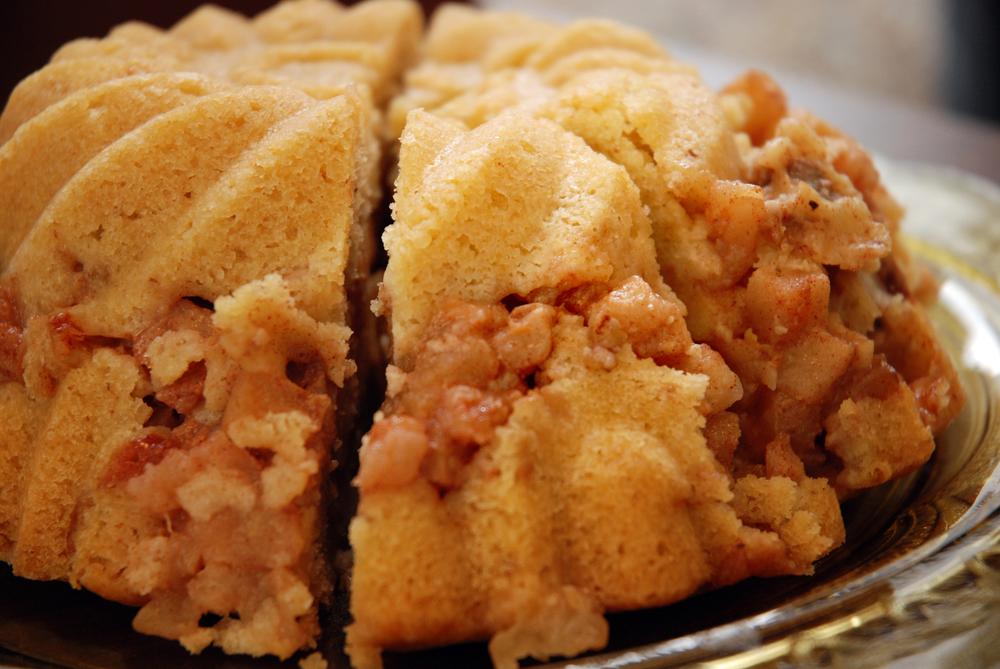
Danielle Fleischman bakes this apple cake in the same beat-up rectangular pan that her mother used. Known as a Jewish Apple Cake because oil is substituted for butter, it is called Gâteau de Hanukkah in France. When Danielle makes the cake, she uses very little batter and half sweet and half tart apples, a combination that makes a really tasty version of this simple Polish cake. Although her mother grated the apples, Danielle cuts them into small chunks. I often make it in a Bundt pan and serve it sprinkled with sugar.
5 apples (3 Fuji and 2 Granny Smith, or any combination of sweet and tart apples), peeled, cored, and cut into 1/2-inch pieces, about 6 cups of apples
Grated zest and juice of 1 lemon
10 walnut halves, roughly chopped
1 ½ teaspoons cinnamon
2 cups all-purpose flour
1 teaspoon baking powder
1/8 teaspoon salt
2 tablespoons chopped almonds
1 ¼ cups plus 3 tablespoons sugar
4 large eggs
1 cup vegetable oil
¼ teaspoon almond extract
Preheat the oven to 350 degrees, and grease a Bundt pan or a 9-by-13-inch baking pan.
Toss the apples in a large bowl with the zest and juice of the lemon, the walnuts, and the cinnamon.
Pulse together the flour, baking powder, salt, almonds, and 1 ¼ cups of the sugar in the bowl of a food processor fitted with a steel blade. With the food processor running, add the eggs, oil, and almond extract, processing until just mixed. Spoon half of the batter over the bottom of the pan. Scatter the apples on top, and cover the apples with the remaining batter. Sprinkle the top with the remaining sugar (you’ll need less if using a Bundt pan). Bake for 45 to 60 minutes or until golden and cooked through. Note: the cake will take a shorter time to bake in the shallow rectangular pan than in the Bundt pan.
Yield: 8 to 10 servings (P)
FRENCH POTATO SALAD WITH SHALLOTS AND PARSLEY
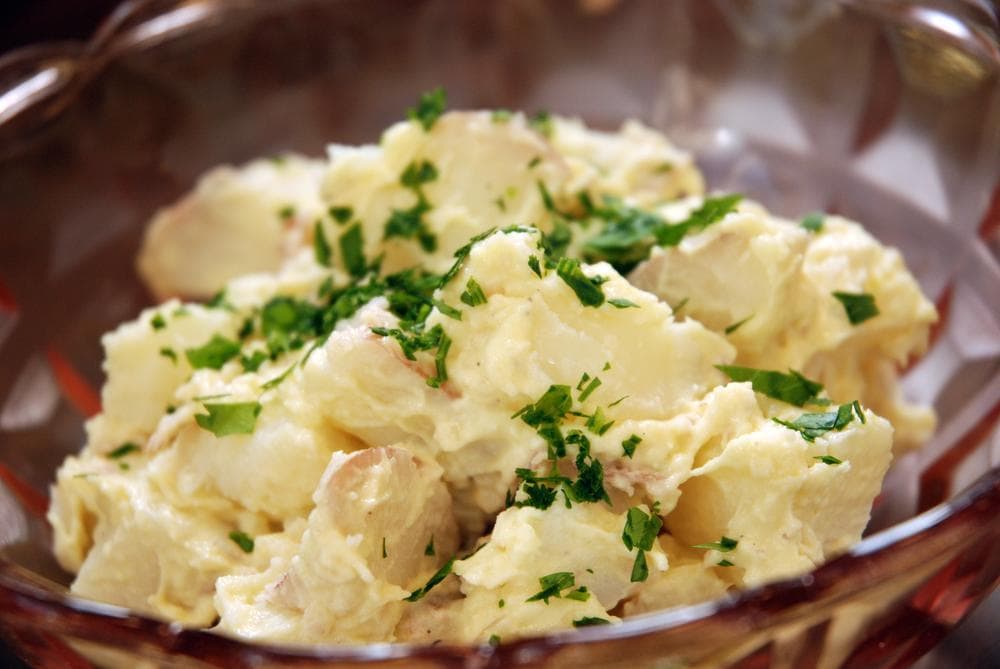
This classic French potato salad is very simple. A non-Jewish version might include lardons (a type of bacon) and shallots, but instead I use a tart mayonnaise. For a North African touch, you can add sliced hard-boiled eggs and black olives. I often add julienned basil with the parsley, or other compatible herbs.
8 large or 16 small potatoes, about 2 pounds
Salt and freshly ground pepper to taste
½ cup finely chopped shallots
1 egg yolk
¼ cup red wine vinegar
½ cup vegetable or olive oil
½ cup freshly chopped parsley
Wash the potatoes under running water, removing any dirt with your hands. Peel them and cut into quarters or eighths, depending on their size, and drop into a pot of water. Bring the water to a boil, add salt to taste and cook until tender but still firm, 8 to 10 minutes. Drain.
Toss the potatoes and the shallots together in a salad bowl.
Using a food processor fitted with a steel blade, blend the egg yolk and vinegar. With the motor running, slowly stream in the vegetable or olive oil. Season with salt and freshly ground pepper to taste. Fold the dressing into the warm potatoes, sprinkle with parsley, and serve warm or at room temperature.
Yield: 6 servings (P)